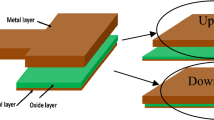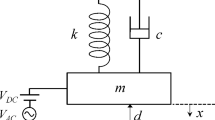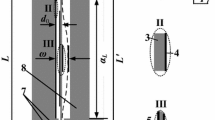Abstract
The derivation, verification, and implication of the nonlinear dynamic and frequency response of electrostatic actuator due to the double frequency effect (DFE) were reported in this study. In particular, an extra mode called half mode was observed and measured in various studies. However, a complete in-depth discussion of the effect was not reported in the past. In the present study, a second-order dynamical equation was adapted firstly to model the dynamic and frequency response of electrostatic actuator where typical harmonic input signal with a dc bias was used. Secondly, by solving the equation, complex waveform in dynamic response and an extra half mode in frequency response due to the double frequency effect can be observed and discussed. To verify the simulated result, an electrostatic driving device was fabricated using PolyMUMPS© process. Note that in frequency response, when dc bias is equal to the amplitude of ac signal, simulated and experimental results indicated that the amplitude of half mode was one-fourth of first mode.








Similar content being viewed by others
References
Chowdhury S, Ahmadi M, Jullien GA, Miller WC (2000) A modular MEMS electromagnetic actuator for use in a hearing instrument. In: Proceedings of the 43rd IEEE midwest symposium on circuits and systems, vol 1, pp 240–243
Fleischmann T, Kubota K, Vaccaro PO, Wang TS, Saravanan S, Saito N (2004) Self-assembling GaAs mirror with electrostatic actuation using micro-origami. Physica E 24:78–81
Haddab Y, Chaillet N, Bourjault A (2000) A microgripper using smart piezoelectric actuators. In: Proceedings of IEEE international conference on intelligent robots and systems (IEEE/RSJ IROS), vol 1, pp 659–664
Hung ES, Senturia SD (1999) Extending the travel range of analog-tuned electrostatic actuators. J Microelectromech Syst 8(4):497–505
Ji CH, Kim YK, Choi BK (2000) Design and fabrication of electromagnetic micromirror with bulk silicon mirror plate and aluminum spring. In: Proceedings of IEEE/LEOS optical MEMS, pp 97–98
Jin Z, Wang Y, Xu Y, Ding C (1995) The properties of micromechanical resonator. In: International conference on solid-state and integrated circuit technology, pp 482–484
Kiang MH, Solgaard O, Lau KY, Muller RS (1998) Electrostatic combdrive-actuated micromirrors for laser-beam scanning and positioning. J Microelectromech Syst 7(1):27–37
Koester DA, Mahadevan R, Markus KW (1994) MUMPS introduction and design rules, MCNC MEMS Technology Applications Center
Lee D, Krishnamoorthy U, Yu K, Solgaard O (2004) Single-crystalline silicon micromirrors actuated by self-aligned vertical electrostatic combdrives with piston-motion and rotation capability. Sensors Actuat A 114:423–428
Lin HY, Fang WL (2003) A rib-reinforced micro torsional mirror driven by electrostatic torque generators. Sensors Actuat A 105:1–9
Mohamed A, Elsimar H, Ismail M (2003) Analysis, and optimization of a CMOS vertical thermal actuator. In: Proceedings of 2003 symposium on design, test, integration and packaging of MEMS/MOEMS, 5–7 May, pp 214–217
Mu XH, Kahrizi M, Landsberger L (2003) Design & fabrication of out-of-plane electrostatic actuators for optical application. In: Proceedings of IEEE Canadian conference on electrical and computer engineering (IEEE CCECE), vol 1, pp 133–136
Park JY, Yee YJ, Nam HJ, Bu JU (2001) Micromachined RF MEMS tunable capacitors using piezoelectric actuators. In: Proceedings of IEEE microwave symposium digest, vol 3, pp 2111–2114
Piyabongkarn D, Sun Y, Rajamani R, Sezen A, Nelson BJ (2005) Travel range extension of a MEMS electrostatic microactuator. IEEE Trans Contr Syst Technol 13(1):138–145
Popa DO, Byoung HK, Wen JT, Stephanou HE, Skidmore G, Geisberger A (2003) Dynamic modeling and input shaping of thermal bimorph MEMS actuators. In: Proceedings of IEEE international conference on robotics and automation (IEEE ICRA ’03), vol 1, pp 1470–1475
Ries LL, Smith SW (1998) Phase aberration correction in two dimensions with an integrated deformable actuator/transducer. IEEE Trans Ultrason Ferroelectr Freq Contr 44(6):1366–1375
Rosa MA, Dimitrijev S, Harrison HB (1998) Enhanced electrostatic force generation capability of angled comb finger design used in electrostatic comb-drive actuators. Electron Lett 34(18):1787–1788
Rosa MA, Bruyker DD, Volkel AR, Peeters E, Dunec J (2004) A novel external electrode configuration for the electrostatic actuation of MEMS based devices. J Micromech Microeng 14:446–451
Tuantranont A, Bright VM (2002) Micromachined thermal multimorph actuators fabricated by multi-users MEMS process. In: Proceedings of IEEE international conference on industrial technology (IEEE ICIT ’02), vol 2, pp 941–944
Wilfinger RJ, Bardell PH, Chhabra DS (1968) The resonistor: a frequency selective device utilizing the mechanical resonance of a silicon substrate. IBM J Res Dev 12:113–118
Acknowledgments
This work was supported in part by Ministry of Economic Affairs, Taiwan, ROC under Contract No. 92-EC-17-A-07-S1-0011, the National Science Council, Taiwan, ROC under Contract No. NSC 94-2218-E-009-031, NSC 94-2215-E-009-056 and by the Brian Research Center, University System of Taiwan, under Grant 92B-711.
Author information
Authors and Affiliations
Corresponding author
Rights and permissions
About this article
Cite this article
Chiou, J.C., Lin, Y.J. Modeling and verification of the double frequency effect using a MEMS device. Microsyst Technol 12, 796–802 (2006). https://doi.org/10.1007/s00542-006-0168-1
Received:
Accepted:
Published:
Issue Date:
DOI: https://doi.org/10.1007/s00542-006-0168-1




